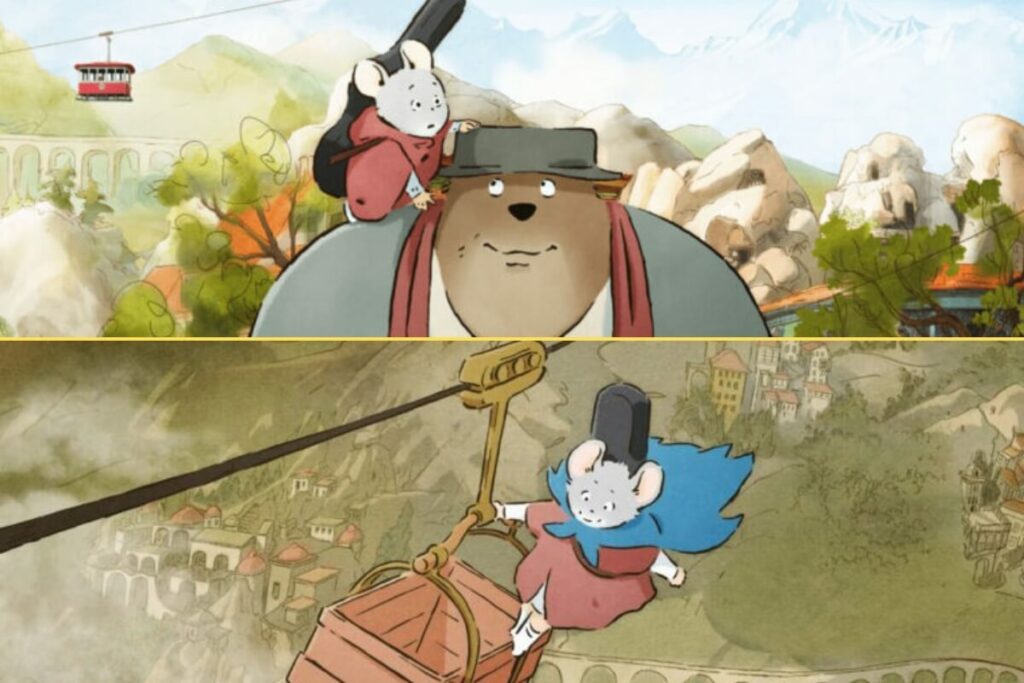“Ernest & Celestine: A Trip to Gibberitia” builds upon the endearing foundation laid by its predecessor, offering viewers a deeper and more thought-provoking journey into the world of Ernest and Celestine.
Directed by Julien Chheng and Jean-Christophe Roger, this animated gem invites us back into the heartwarming friendship between a bear and a mouse, while exploring themes of conformity, identity, and the power of music.
A Delightful Beginning
“Ernest & Celestine: A Trip to Gibberitia” kicks off with a delightful charm that’s impossible to resist. It introduces us to Ernest and Celestine, voiced brilliantly by Lambert Wilson and Pauline Brunner.
The chemistry between these characters is heartwarming, their interactions brimming with genuine affection. Against the soft, hand-drawn animation, the film feels like a nostalgic journey into a cherished picture book from childhood. The warmth of their friendship is palpable, making it easy for viewers of all ages to connect with their endearing dynamic.
A Dream Turned Nightmare
Early in the film, we are treated to Ernest’s dream—a sequence that unfolds with captivating artistry. At first, it’s a utopia, where Ernest plays his violin to a joyous crowd. Yet, as quickly as it begins, the mood shifts, and we are thrust into a Kafkaesque nightmare.
The dream sequence raises profound questions about Ernest’s past and introduces a layer of complexity to the story. It’s here that the film takes an introspective turn, setting the stage for the deeper themes that will unfold.
Subtle Political Allegory
The heart of the film is set in Gibberitia, a seemingly idyllic place with a picturesque facade. However, as the story unfolds, we discover the hidden depths of this society—a place where conformity is enforced through unsettling methods. Gibberitia becomes a powerful backdrop for a subtle yet thought-provoking political critique.
It challenges viewers to contemplate the consequences of a world where creativity and individuality are suppressed, leaving us with a haunting mantra, “That’s just how it is.” This allegory is masterfully executed, providing a unique opportunity for both children and adults to engage with themes of societal norms and the importance of resistance.
These elements combine to create a rich and layered narrative that elevates “Ernest & Celestine: A Trip to Gibberitia” beyond the realm of typical animated films. The movie seamlessly blends heartwarming charm, artistic brilliance, and profound reflection, offering an experience that resonates deeply with its audience.
It’s a testament to the power of storytelling when it combines innocence with introspection, leaving viewers with a sense of wonder and contemplation long after the credits roll.
Celestine’s Can-Do Spirit
Celestine’s unwavering optimism shines brightly throughout the film, as she embarks on a quest to find the Musical Resistance. Her determination to break free from the shackles of conformity is both inspiring and relatable for viewers of all ages. Her journey becomes a symbol of youthful rebellion against societal expectations.
Ernest’s Loneliness and Longing
On the other hand, Ernest’s character embodies the loneliness and longing of someone who has left their homeland. His experiences in Gibberitia are deeply intertwined with the nostalgia and yearning for a sense of belonging.
This adds a layer of emotional depth to the film, resonating with those who have experienced displacement or disconnection.
The Heart of the Film
Amidst the political commentary and philosophical ponderings, the heart of the movie remains the beautiful friendship between Ernest and Celestine.
Their stark differences—age, outlook on life—underscore the importance of unity and understanding. They are a testament to the delicate balance between innocence and experience, evoking William Blake’s profound poetry.
Conclusion
“Ernest & Celestine: A Trip to Gibberitia” is a multi-layered masterpiece that seamlessly weaves together a touching friendship narrative with astute political allegory. While its deeper themes may be more appreciated by older viewers, the film never loses its charm and appeal to younger audiences.
It encourages us all to reflect on the value of friendship, individuality, and the courage to resist conformity, making it a delightful and thought-provoking cinematic experience for the entire family. This enchanting sequel stands as a testament to the enduring magic of storytelling and the enduring power of friendship, leaving viewers with a sense of warmth and contemplation that lingers long after the credits roll.

